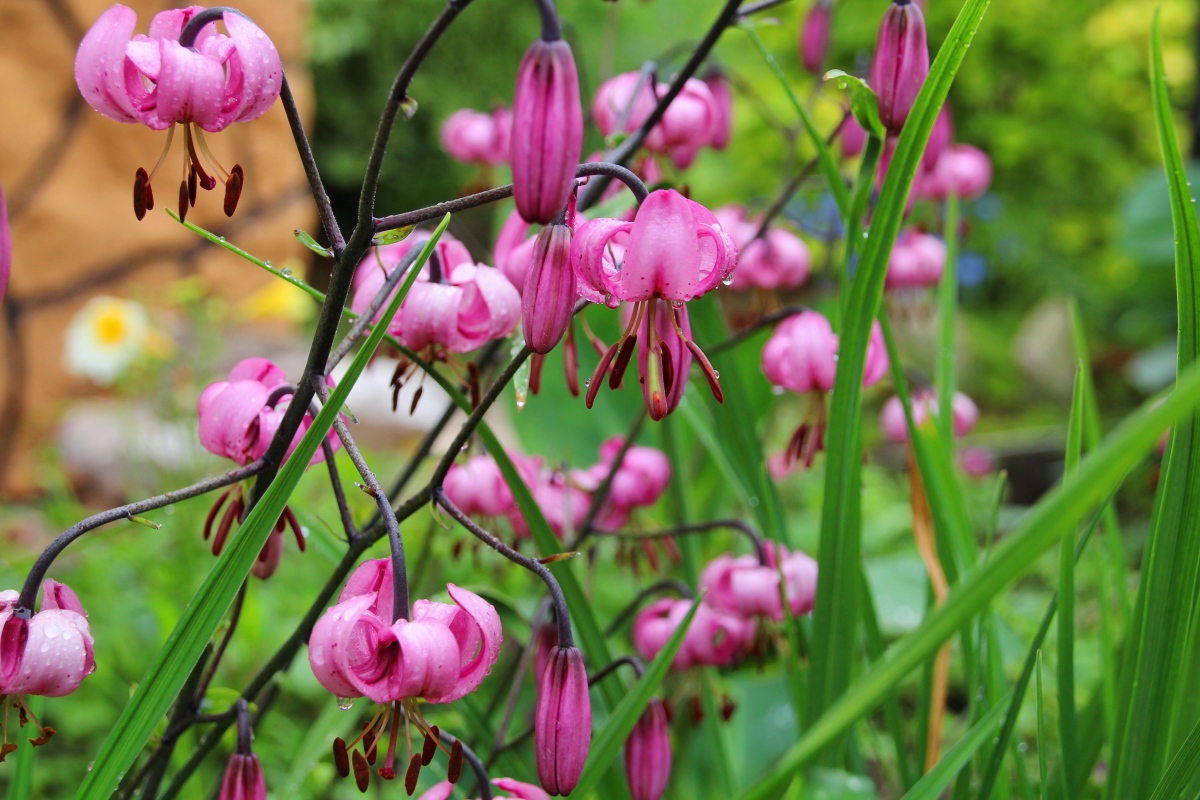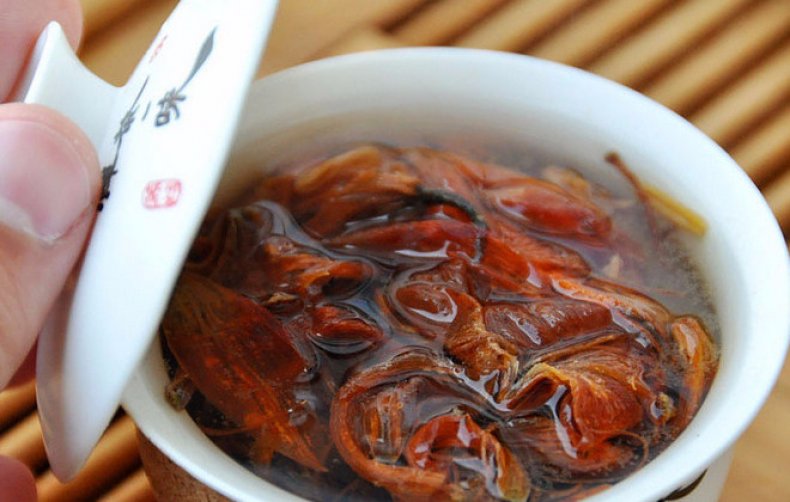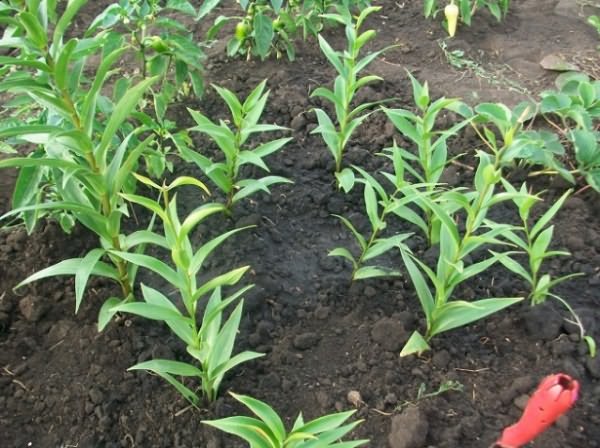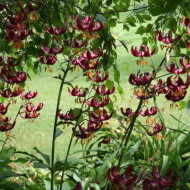All about curly lily: description, useful properties and subtleties of growing
Content
Description and distribution of Kudrevataya lily
Although the culture is forest, in the wild it can be found infrequently, therefore it is included in the Red Book in Ukraine, Belarus, the Republic of Mari El and the Siberian regions of Russia. It is suitable for the Carpathian and Transcarpathian areas, it also grows in the North Asian region, Siberia. It is a part of forest and meadow biogeocenoses, prefers to settle in sunny areas, that is, in glades, in woodlands, on mountain slopes.

Among the people, the melliferous plant has dozens of names: saranka, sardana, badun, butter, royal curls, martagon. Alas, the beautiful appearance and the presence of medicinal properties led to the widespread collection of perennials. As a result, only small populations survived in nature. But measures are being taken and, according to environmentalists, the situation will improve over time.
Curly lily has the following description:
- Tall (from 30 cm to 1, m) perennial shrub-type plant.
- The root system is formed from a fleshy, massive (up to 8 cm in diameter) yellow or brown scaly bulb.
- Powerful, rounded stem with red dots.
- Foliage is numerous, elongated (up to 15 cm), grouped in 5-6 pieces.
- Spreading flower stalks, drooping inflorescences, resemble a Turkish turban in shape.
- The flowers are purple, orange, purple, white and black.
- The petals curl towards the stem, covered with purple dots at the bottom.
- After planting, it blooms for 4–5 years. The growing season begins at the end of June and lasts 2-3 weeks.
The progenitor of cultivated varieties is the Martagon lily, which grows even in the harsh Siberian climate. Accordingly, the described species has increased frost resistance.

Medicinal properties of the plant
The culture includes many protein components, ascorbic acid, vitamins, sugar, iron and other useful substances. In some countries it is eaten:
- the bulbs are edible raw (they taste like garlic), they are also boiled and baked;
- flour is prepared from the powder of dry bulbs;
- after heat treatment, seasonings for meat dishes are obtained;
- in dried form, they can be successfully substituted for a coffee drink.
The oils squeezed out of flowers are used by cosmetologists to create facial masks.
Application in traditional medicine
The plant was massively used in the eastern regions: in Buryatia, in Tibet, in Siberian tribes. All parts of a perennial are suitable for a natural pharmacy, infusions, medicinal decoctions, extracts and compresses are prepared from them:
- onion tincture is made as a sedative that helps relieve stress and relieve depression, to increase appetite;
- flower broths treat gallbladder diseases, relieve toothache;
- the juice of the plant has an anti-inflammatory effect, is used to heal wounds and burns.
To prepare the tincture you need:
- Pour boiling water over a small onion, making sure that it is completely immersed;
- insist 15 minutes;
- filter through a sieve or cheesecloth.
It is recommended to take 15 ml 3 times a day.

Harm and contraindications for use
There are situations in which the use of decoctions and tinctures of the culture can cause headaches. This is due to the individual intolerance of some of its constituent substances.
People prone to allergies are not recommended to inhale the aroma of the plant, as well as to take any remedies based on it.
Pros and cons of culture
- high resistance to frost;
- pickiness in leaving;
- medicinal and nutritional properties;
- ease of reproduction.
- weak resistance to fungal diseases;
- photophilous - blooms in the shade, but not abundantly, much better in the light;
- attracts pests.
Video "Curly Lily in the Garden"
This video covers the basic rules for growing a flowering crop.
Optimal growing conditions
The more sun illuminates the plant, the more abundant the flowering will be. Lily is hygrophilous, so you have to make sure that the soil remains moist.
Choose a sunny area with good drainage. The soil is prepared in advance:
- dig 2 shovel bayonets to a depth;
- sandstone is mixed with loam or the base of the flower bed is covered with clay;
- heavy earths are loosened, diluted with sand, peat and humus are added.
It is undesirable to use fresh manure to fertilize the soil.

Description of the planting process
Sowing material is planted either at the end of August - September or in early spring. Autumn plantings must be mulched with peat (covering layer 20 cm), then in the first year a weak flowering will appear. When planting in the spring, a short stem sometimes grows, but more often nothing appears from the soil.
Suitable material is considered to be medium-sized bulbs with no visible defects. Here is a description of the planting process:
- digging holes to a depth of 20-25 cm for large bulbs, 10-15 cm for small specimens;
- placing the seed in the hole, the roots are carefully straightened;
- drip with earth, moisten;
- mulch.
Reproduction methods
The main method is with scales. They are engaged in it in the fall, the technique is as follows:
- Break the ground to a bulb (do not dig it out), separate the required number of scales.
- The collected material is washed and disinfected in Vitaros.
- The scales are kept on wet bog moss in order not to dry out the forming roots, at the same time protecting them from an excess of moisture.
- After 2–2, 5 months, a bulb will begin to form on the scales.
- The seed is stored in a cool place, planting in the ground is carried out in the spring. Do this in a small container, slightly add soil. In winter they cover a little.
Plants planted using this technique will begin to bloom in the 5-7 year.

Another method is by seed. These are the same bulbs, but forming in the leaf axils. The algorithm is as follows:
- When the foliage falls off, the seeds fall into the ground and germinate by the next year.
- In the spring, sprouts with weak roots hatch near the flower.
- A year later, one leaf will appear on the sprouts.
- By the age of 3, a mature plant begins to form a stem.
- At the 5th year, a flower will appear.
Given such a long maturation, it is not surprising that the average lifespan of a perennial is 22 years.Immediately after ripening, the seeds must be harvested, kept in winter at –2 ° С, in spring at +20 ° С. Then sow in boxes for seedlings, and in May, plant in the ground.
Care features
They take care of the growing crop, carrying out timely watering and making the necessary top dressing. Since the plant loves moisture, watering should be done whenever the topsoil dries up. Watering is done exclusively at the root, making sure that moisture penetrates to a sufficient depth.

Fertilizers are added several times per season:
- in the spring - mineral;
- during budding - phosphoric;
- in the fall - phosphorus-potassium.
Humus in mulch can replace top dressing. Given the increased frost resistance, it is not necessary to cover the shrub for winter. But in the northern regions, it is better to protect young seedlings by mulching the crops with a layer of foliage, spruce branches.
Diseases and pests of culture
Lily Curly is immune to most diseases. But in case of violations of agricultural technology, in particular - an excess of moisture and insufficient ventilation, the bulbs begin to rot, the foliage becomes covered with brownish-gray spots (botrytis).
It is easier to prevent the disease by making sure that the planting sites are not flooded, and at times by loosening the soil. However, during the rainy season, fungal ailments can appear, despite careful care, therefore you need to know the methods of struggle.
- Gray rot (botrytis). It is treated with systemic fungicides such as "Skor", "Topaz". Fitosporin is suitable for prophylaxis.
- Lily fly. The affected plant cannot be cured. Only timely preventive measures help, that is, starting from May, crops are sprayed with an insecticide, for example, "Aktara".
To prevent fungal diseases, complex spraying with the formulations "Fundazol", "Oxyhom" or "Fitosporin" is also carried out. Processing is carried out in stages:
- the first - in the spring with the appearance of sprouts;
- the second - after 3-4 weeks;
- the third (if the rains do not stop) - in a month.
The crop can be attacked by pests. The most dangerous for the species are lily beetles ("firemen"). Beetles eat young shoots, lay larvae, which eventually turn into adults. Insecticides "Iskra", "Inta-Vir", etc. can be used against pests.
Flower Tsar's curls in landscape design
The saranka is more suitable for decorating gardens and summer cottages; you can hardly find it on city flower beds. This is explained by the ability of the perennial to grow rapidly, capturing the surrounding space and suppressing neighboring crops. Therefore, royal curls are recommended:
- for isolated flower beds;
- in the vicinity of fruit trees and shrubs;
- combined with bushes of roses, iris, peonies.
- Landscaping of the recreation area
- Flower beds
- Plot decoration
Lily Kudrevataya is planted not only for the sake of beauty and exoticism, but also for its beneficial properties. Considering that the plant is included in the Red Book, planting perennials in the garden area will allow the gardener to make a contribution to the revival of culture.



